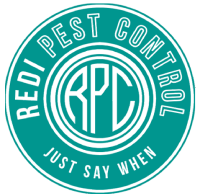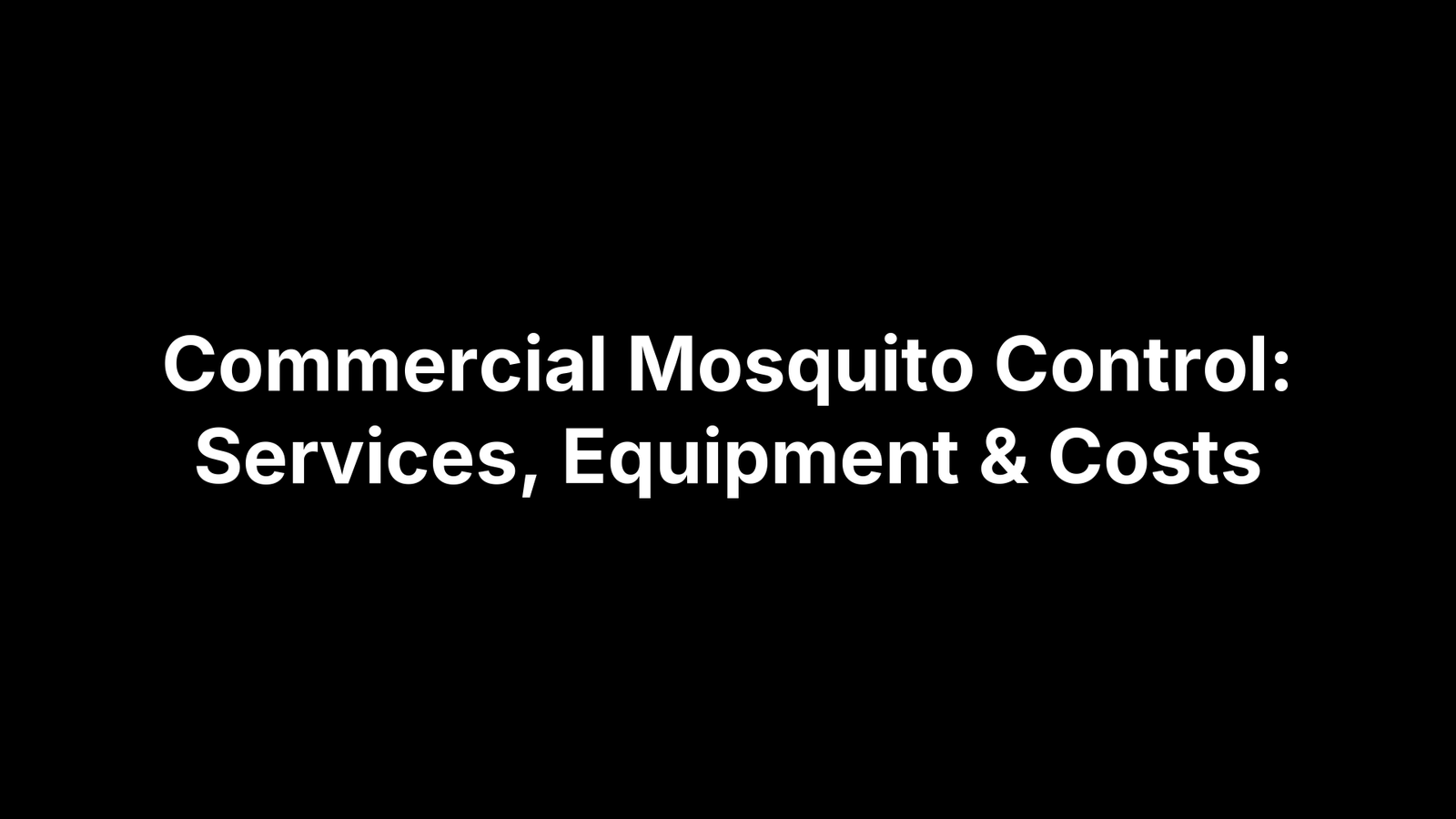Commercial mosquito control is the systematic prevention and treatment program businesses use to keep mosquitoes from disrupting people and operations. It combines site inspections, water management, larval treatments, targeted adult knockdown, and ongoing monitoring—executed by licensed pros with commercial-grade equipment and EPA-registered products. The result: fewer bites, lower disease risk, better guest and employee experience, and protection for brands that depend on outdoor areas to function.
In this guide, you’ll learn what commercial mosquito control covers, how seasonality and mosquito biology shape plans, and how integrated mosquito management works day to day. We’ll break down tools for larvae and adults, equipment and chemistries, safety and regulations, service models and scheduling, costs, DIY vs. pro, how to vet a provider, and answers to common questions.
What commercial mosquito control covers
Commercial mosquito control spans the entire property and mosquito life cycle. Programs include up-front inspection, source reduction to eliminate standing water, targeted treatments for larvae and adults, and routine monitoring with documentation. The goal is measurable bite reduction, regulatory compliance, and a safer experience for employees, guests, and tenants.
- Site risk assessment: Mapping and prioritizing breeding and resting areas.
- Larval control: Larviciding with Bti or insect growth regulators in defined water habitats.
- Adult mosquito control: ULV space sprays (ground or truck-based) for rapid, short-term knockdown when thresholds are met.
Mosquito biology and seasonality that affect businesses
Understanding mosquito biology helps time commercial mosquito control plans and budgets. Mosquitoes develop as aquatic larvae and pupae in standing water—clogged gutters, flat roofs, ditches, tarps, ornamental pools, and sluggish streams. Large numbers can emerge when water stands a week or longer. Adults then rest in shaded vegetation around buildings. For businesses, post-rainfall, irrigation, and construction increase risk near landscaped edges—making frequent inspections and targeted larval control essential.
How integrated mosquito management works for businesses
Integrated mosquito management (IMM) for businesses is a continuous cycle of prevention, targeted control, and verification. It reduces bites by addressing breeding, resting, and flying stages with season- and site-specific tactics.
- Assessment: Inspect roofs/gutters, ditches, tarps, ornamental water, and shaded vegetation.
- Source reduction: Remove containers, fix leaks, and improve drainage/irrigation.
- Larval control: Treat defined water with Bti or methoprene (IGR); focus near shorelines.
- Resting-site tactics: Mow weeds; optional residuals on shaded lower limbs (deltamethrin, lambda-cyhalothrin).
- Adult control (as needed): ULV truck/ground sprays for quick, short-term knockdown during surges or disease response.
- Verification: Ongoing surveillance and service logs to time treatments and demonstrate results.
Larval control tools and products used by professionals
In commercial mosquito control, larval work delivers the biggest, longer‑lasting impact. Pros treat defined water where mosquitoes develop—often the shoreline zones of ponds, ditches, and containers—so only habitats with larvae are treated, limiting non‑target exposure. Common formulations are granules, bits/briquets, liquids, and surface agents matched to the site and water type.
- Bti: Biological larvicide that kills larvae when ingested; often applied as bits/briquets.
- S‑methoprene (IGR): Disrupts development to stop adult emergence in treated water.
- LarvaSonic: Acoustic larvicide that uses sound energy to kill larvae in water.
Adult mosquito control methods and when they’re used
Adult control provides rapid, short‑term relief when surveillance shows population spikes, complaints surge, or infected mosquitoes threaten public health. Pros target flying and resting adults while limiting non‑target exposure. Because adulticiding is short‑lived, it’s deployed only as needed and always paired with larval control and source reduction.
- ULV truck/ground sprays: Quick knockdown using labeled pyrethrins/pyrethroids; minimal residual impact.
- Aerial adulticiding: Fixed‑wing or helicopter treatments for inaccessible areas during surges or disease response.
- Residual vegetation treatments: Targeted pyrethroids (e.g., deltamethrin, lambda‑cyhalothrin) on shaded resting sites.
- CO₂ traps (supplemental): Limited, variable efficacy; use alongside core larval and source reduction work.
Equipment used in commercial mosquito control
The right gear lets pros target larvae and adults precisely while covering large areas quickly. Commercial mosquito control equipment spans surveillance tools and application platforms built for consistency, droplet control, and regulatory compliance.
- ULV sprayers (truck/ATV/handheld): ultra‑fine droplets for rapid adult knockdown.
- Aerial application (fixed‑wing/helicopter): surge response for broad or inaccessible areas.
- Backpack/compressed‑air sprayers: precise residual treatments on shaded vegetation and perimeters.
- Larvicide applicators: granular spreaders, briquet/IGR dispensers, and acoustic units for water.
Chemicals and active ingredients used in treatments
Pros match actives to the mosquito life stage and site conditions. Larvicides target confined water; adulticides provide short‑term knockdown when needed. Here are commonly used active ingredients in commercial mosquito control.
- Bti: Biological larvicide that kills larvae when ingested.
- S‑methoprene (IGR): Prevents emergence of biting adults.
- Pyrethrins: Fast knockdown in space sprays and fogging.
- Synthetic pyrethroids (allethrin, resmethrin, deltamethrin, lambda‑cyhalothrin): Used for residual vegetation treatments and ULV space sprays.
- Malathion (5%): Labeled for outdoor fogging in some programs.
Safety, regulations, and environmental best practices
Safety and compliance sit at the core of commercial mosquito control. Programs use EPA-registered products applied by licensed technicians according to the label, with treatments targeted to specific habitats and life stages to reduce non-target exposure. Because adulticiding can affect non-target organisms if mishandled, it’s reserved for defined needs and paired with larval control and source reduction.
- Prioritize source reduction: Remove or drain standing water to prevent breeding.
- Target larvae precisely: Treat only water harboring larvae, often along shorelines, with Bti or S‑methoprene (IGR).
- Use adulticides judiciously: Deploy ULV sprays or aerial work only when surveillance indicates surges or disease risk.
- Calibrate and document: Maintain equipment calibration, mapping, and service logs for accountability.
- Vegetation management first: Mow and thin shaded areas; apply labeled residuals to resting sites only when needed.
- Respect wetland rules: Don’t alter ditches or protected areas; report stagnant water to local mosquito control or public health offices.
- Always follow labels: Only insecticides labeled for flying insects and site conditions should be used as directed.
Service models, scheduling, and what to expect on service day
Commercial mosquito control is delivered through structured service models: recurring seasonal programs with scheduled inspections and larval treatments, surge or disease-response adulticiding triggered by surveillance thresholds, and one‑time special‑event treatments. Scheduling aligns with local seasonality, rainfall, and site risk, with weather-appropriate windows for ULV applications.
- Walk‑through & source reduction: Locate hotspots; remove standing water.
- Larviciding: Apply Bti or S‑methoprene in defined water.
- Adult control (if triggered): Residual vegetation or ULV spray; document results.
Costs and pricing factors for commercial mosquito control
Budgets for commercial mosquito control are typically built as seasonal programs or per‑event services, often priced per acre, per site, or per visit. Quotes usually bundle inspection, source reduction, larval work, and as‑needed adult knockdown with documentation and reporting. Expect costs to reflect your risk profile, access, and response expectations.
- Property size & water complexity: Acreage, number of water features, ditches, flat roofs, and containers.
- Program frequency & season length: More visits in longer, wetter seasons.
- Treatment mix: Larval control as baseline; ULV truck sprays added as needed; aerial adulticiding carries higher costs due to manpower/equipment.
- Access & vegetation density: Impacts labor time and product needed.
- Compliance & documentation needs: Labels, maps, calibration records, and reporting.
- Response windows & thresholds: Faster complaint/disease response increases cost.
- Special events & surge treatments: One‑off pre‑event applications.
- Portfolio scale: Multi‑site contracts may reduce per‑site rates.
Ask providers to itemize larval, adult, and surveillance components and define clear trigger thresholds for adulticiding.
DIY options versus hiring a professional service
DIY can address small, contained issues, while commercial mosquito control scales compliance and results. Strong DIY: rigorous source reduction plus larvicides such as Bti “dunks/bits” or S‑methoprene IGR tablets in stagnant water. Hand‑held ULV foggers give brief relief but require strict label use.
- DIY fits: small sites with containers, gutters, tarps, ornamental pools.
- Hire pros when: large/complex sites, disease advisories, wetlands, access limits.
- Pros add: surveillance, calibrated ULV, records for compliance and auditing.
How to evaluate and choose a commercial mosquito control provider
Choose on evidence. Favor licensed teams using EPA‑registered products and integrated mosquito management that leads with source reduction and larvicides (Bti or S‑methoprene) and reserves adulticiding for defined thresholds. Require written documentation, calibrated equipment, and practices that follow labels, protect wetlands, and limit non‑targets. Ask for recent references and sample reports.
- Licensing & insurance: trained, locally licensed technicians.
- IMM plan: site‑specific and written.
- Surveillance & thresholds: clear triggers for adulticiding.
- Toolbox: larvicides, residuals, ULV; aerial access if needed.
- Reporting & fit: maps/logs, response times, itemized pricing, references.
- Safety & environment: label adherence, shoreline targeting, wetland coordination.
Preparation checklist for your property team
A short pre-service sweep by your facilities crew boosts results and reduces callbacks. Tackle water, vegetation, access, and communication so technicians can focus on precise larval treatments and targeted adult knockdown. Use this quick checklist 24–48 hours before your scheduled commercial mosquito control visit.
- Drain/remove containers: buckets, tires, saucers, tarps.
- Clean gutters/roofs: fix leaks; eliminate puddles.
- Prep water features: Bti or S‑methoprene treatment plan.
- Mow/trim vegetation: reduce shaded resting sites.
- Access & notices: unlock gates; inform staff; report stagnant ditches—do not alter protected wetlands.
Industry-specific considerations and solutions
Different industries face unique mosquito pressures—from ornamental water features to shaded loading bays. Tailored programs pair source reduction with larvicides (Bti or S‑methoprene) and reserve adult treatments for defined thresholds, with documentation to protect brands, people, and compliance.
- Hospitality/HOAs: Treat ponds with Bti/IGR; trim shade; pre‑event ULV if triggered.
- Industrial/logistics: Fix roof/gutter drainage; apply residuals on shaded resting sites.
- Construction: Empty tarps/containers; weekly post‑rain checks; targeted larviciding on-site water.
- Parks/municipal/golf: Shoreline larviciding; report stagnant ditches (wetland rules); coordinate truck sprays.
Common questions about commercial mosquito control
Businesses want predictability, safety, and clear outcomes. Below are quick answers grounded in integrated mosquito management practices used by professional programs so you know what to expect and how to support results between visits.
- How long do results last? Adult ULV provides rapid, short‑term knockdown; larval control tackles the source. Monitoring dictates re‑treat timing.
- Is it safe for people and pets? Licensed teams use EPA‑registered products per the label and target habitats to limit non‑target exposure.
- Will sprays harm pollinators or fish? Risk rises if mishandled; programs prioritize source reduction and targeted larval work in defined water and treat resting sites only as needed—while respecting wetland rules.
- Do CO₂ traps replace treatments? No. Effectiveness is variable; traps are supplemental to larval control and source reduction.
- What about rain events? Post‑rain inspections are essential; standing water that persists a week can produce large numbers, so eliminate containers and fix drainage.
- How often are services scheduled? Seasonal, recurring visits for inspection/larviciding, with adulticiding triggered by surveillance thresholds or special events.
- Can we clear problem ditches ourselves? Don’t. They may be protected; report stagnant ditches to local mosquito control or public health.
- What should we do between visits? Remove standing water, clean gutters/flat roofs, change ornamental/birdbath water weekly, and mow/trim shaded vegetation.
Conclusion
Commercial mosquito control pays off when it’s planned, targeted, and verified. Lead with source reduction and larval control, add adult knockdown only when thresholds demand it, and document results to protect people, budgets, and brand. If you need a site-specific program—inspection, larviciding, calibrated ULV, and clear reporting—our licensed pros can help. Contact Redi Pest Control to schedule a walkthrough and get a transparent plan and quote tailored to your property and risk.


